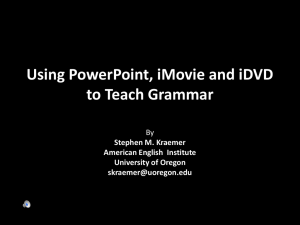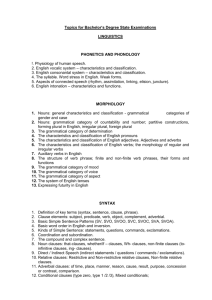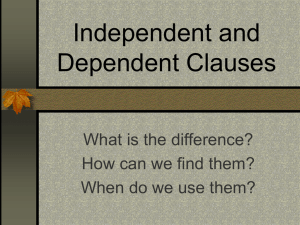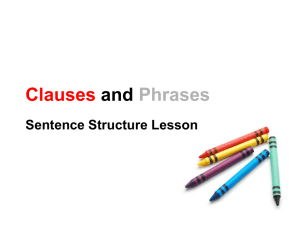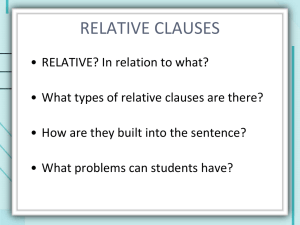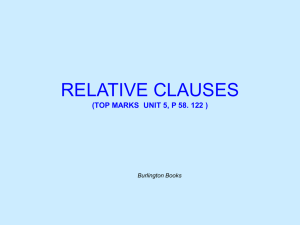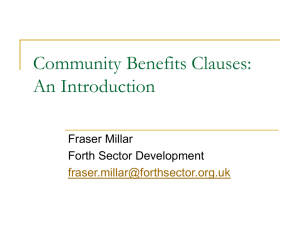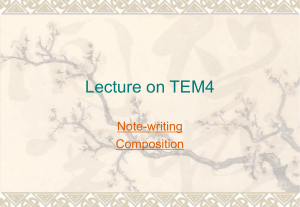The many faces of distribution: tracing the development of linguistic
advertisement
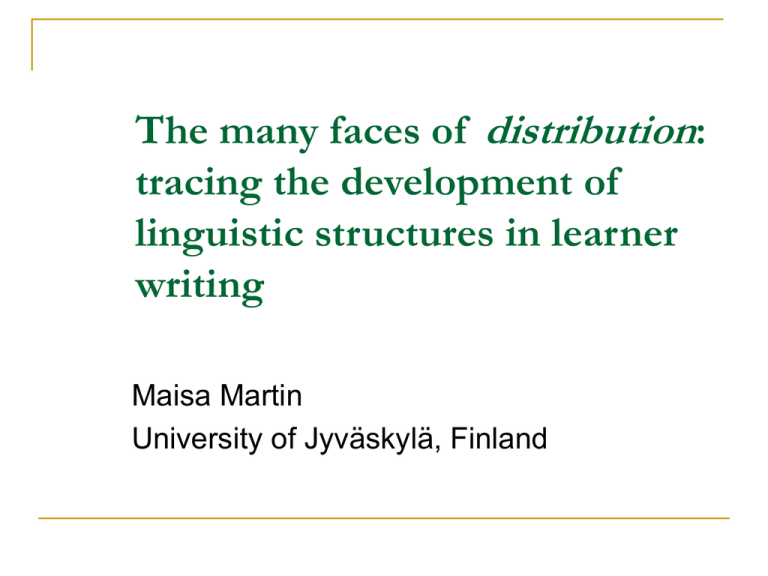
The many faces of distribution: tracing the development of linguistic structures in learner writing Maisa Martin University of Jyväskylä, Finland Development of linguistic skills Three dimensions of development: fluency, accuracy and complexity. All difficult to operationalize but complexity particularly so. The topic: many faces of complexity – in search for measures. Related concepts: distribution context Stucture of the presentation The Cefling Project and the SLATE network DEMfad Model Grammatical complexity measures Problems and solutions (?) Discussion CEFLING: The linguistic basis of the Common European Framework levels: Combining second language acquisition and language testing research SLATE Second Language Acquisition and Testing in Europe An informal network to bring together researchers from SLA and Testing Research around the Common European Framework of Reference (CEFR) levels and their relationship to linguistic development Cefling Rationale CEFR very influential in Finland: - * school curricula - * adult education curricula - * National Certificates of Proficiency - * citizenship requirements Research Question What combinations of linguistic features characterise learners’ performance at the proficiency levels defined in the Common Framework and its Finnish adaptations? Subjects and Languages Written performances of adults taking the National Certificate of Proficiency examination (3 texts per participant) Similar texts on similar tasks from young learners (grades 7 – 9, ages 13-16) L2 Finnish – L1 varies L2 English – L1 Finnish or Swedish L1 control groups Tasks: formal and informal messages, argumentative texts, narratives Rating of the Data functional can-do scales, no reference to language three – four trained raters per writing sample inclusion for main data: complete interrater agreement or two in agreement, one + or – one level Problems with certain levels not enough A1 for adults and C1 and C2 for young writers Coding of the Data CHILDES (.chat format, CLAN tools) Basic coding for all data, structural features as needed (several for Finnish, fewer for English at the moment) Automatic analyses for English only DEMfad MODEL (Franceschina et al. 2006) D D = Domain E = Emergence f E a M M = Mastery f = frequency d a = accuracy d = distribution DEMfad MODEL Domain = linguistic structure or vocabulary area in focus Emergence = first occurrence (chunk or not) Mastery = 80 – 90 % occurrence in obligatory contexts Frequency per 1000 words (~ Fluency) Accuracy (%, criteria defined for each D) Distribution ~ Complexity? Complexity measures Wolfe-Quintero et al. 1998 Larsen-Freeman 2006 Verspoor et al. 2004 Banerjee et al. 2007 Wolfe-Quintero et al. Clauses, T-units, sentences Reduced clauses, dependent clauses, passives, passive sentences, adverbial clauses, adjective clauses, nominal phrases, prepositional phrases, preposed adjectives, pronouns, articles, connectors, transitional connectors, subordinating connectors, coordinating connectors. Larsen-Freeman et al. grammatical complexity = average number of clauses per t-unit many other measures as well, but listed as measures of fluency, accuracy, or lexical complexity Verspoor et al. Development is defined as greater fluency (more words per entry, fewer Dutch words, longer sentences, and more complexity) and/or accuracy (fewer misspellings, fewer grammatical errors, and so on). i.e. do not separate grammatical complexity from other features (choice below mine): the number of conjunctions used to connect clauses, the use of tenses the word order determiners prepositions Banerjee et al. T-units Main clauses Dependent clauses: relative Dependent clauses: adverbial Dependent clauses: non-finite Fragments ’Double’ embedded clauses Ellipsis Problems Overlap between frequency, accuracy, and complexity: is this a problem? No, if overall development is the aim Yes, if more detailed profile is sought Low predictive value Concentration on syntax – morphology can be complex as well Is complexity processability? Is complexity computational? Is complexity desirable? Complexity as processability Processability Theory Processing capacity a feasible factor in the growth of complexity + Clear framework with spelled-out methodology + Addresses limited area of the growth of complexity (syntax) Dependent on one grammatical theory (LexicalFunctional Grammar) - Example 1: Computational complexity. Error % by word type 30 25 20 i:i i:e 15 i:e:C si 10 5 0 A1 A2 B1 B2 C1 C2 TOTAL Is complexity desirable? Example 2 Subordinate clauses per T-unit What if Subordination is a simple matter of starting the clause with a conjunction – with adults the idea of subordination exists > why complex? The culture values short and clear sentences and lengthy and complicated expressions are not considered good style? Other approaches Construction Grammar: growth as extension of constructions (semantic, lexical, structural) Growth as distribution: number of contexts of a structure ”Close distribution” (mandatory arguments, Paavola 2008) Growth at several levels: layers of morphology and syntax (Nieminen 2007 in L1) Conclusion Wolfe-Quintero et al. 1998: ”the goal of - - grammatical complexity studies should be to correlate individual measures for a wide variety of structures - - but that is largely uncharted territory.” References Banerjee J, Franceschina F, Smith AM. 2007 Documenting features of written language production typical at different IELTS band score levels. In: IELTS Research Reports 7. London: British Council. Franceschina, F. 2007 Aspects of the development of number marking in L2 English. Paper presented at AFinLA Conference, Kouvola, Finland, 9-10 November 2007. http://www.jyu.fi/hum/laitokset/kielet/cefling/en/pub Larsen-Freeman, D. 2006 The Emergence of Complexity, Fluency,and Accuracy in the Oral and Written Production of Five Chinese Learners of English. Applied Linguistics 27/4: 590–619. Martin, M. 2007 Emergence, mastery and distribution. Can acquisition criteria be combined? Paper presented at EUROSLA 17 Conference, 11-14 September 2007, Newcastle-upon-Tyne, UK. http://www.jyu.fi/hum/laitokset/kielet/cefling/en/pub Nieminen, L. A complex case: a morphosyntactic approach to complexity in early child language 2007. Jyväskylä Studies in Humanities. Paavola, V. 2008 Haluatko menna muunkansa kalastaman? Verbiketjujen kehkeytyminen suomi toisena kielenä -oppijoiden kielessä. MA thesis. University of Jyväskylä. Verspoor, M.H., K. de Bot & W.M. Lowie, “Dynamic systems theory and variation: a case study in L2 writing.” In H. Aertsen, M. Hannay & R. Lyall, Words in their places: a Festschrift forJ. Lachlan Mackenzie. Amsterdam: VU, 2004. pp. 407-421. Wolfe-Quintero, K. & Inagaki, S. & Kim, H.-E. 1998 Second language development in writing: measures of fluency, accuracy, and complexity. Technical report #17. Second Language Teaching & Curriculum Center. University of Hawai’i at Mãnoa.
